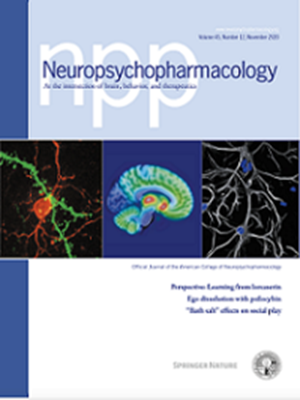氟西汀慢性治疗可调节前额皮质小蛋白阳性中间神经元的线粒体特征和可塑性相关转录组通路。
IF 6.6
1区 医学
Q1 NEUROSCIENCES
引用次数: 0
摘要
氟西汀是一种广泛使用的选择性血清素再摄取抑制剂(SSRI),已知可促进神经可塑性。氟西汀在可塑性中的作用与细小蛋白阳性中间神经元密切相关,这是gaba能神经元中调节抑制性张力和网络稳定性的关键群体。虽然我们之前的研究强调了氟西汀在视觉皮层和海马体中诱导的可塑性,但其在前额叶皮层(PFC)中的细胞类型特异性作用仍不清楚。本研究旨在探讨慢性氟西汀治疗对PV阳性(PV+)细胞的影响,通过pfc中PV- ires - cred驱动的报告细胞表达进行鉴定。使用翻译核糖体亲和力纯化(TRAP),我们发现氟西汀治疗改变了50种不同生物学途径的表达。下调的途径涉及线粒体ATP的产生,包括电子传递链和核糖体的组成部分。上调的通路与磷酸酶活性、离子通道功能和细胞骨架重塑有关,这些分子广泛涉及突触信号传导和可塑性相关过程。在facs分选的细胞中,PFC PV+细胞的线粒体DNA (mtDNA)表达显著增加,而细胞内ATP水平保持不变。免疫组织化学分析显示,在特定的PFC亚区,PV表达减少,神经元周围网络减弱,表明PV+细胞处于可塑性允许状态。PV+细胞的TOMM22信号强度在前边缘区显示出轻微但显著的增加,提示尽管线粒体基因转录组下调,但可能存在代偿性线粒体生物发生。我们的研究结果表明,慢性氟西汀诱导PFC PV+细胞的协调转录和结构改变,包括线粒体相关基因表达和可塑性相关途径的改变。这些变化可能有助于皮层抑制和可塑性的区域特异性变化,补充了先前关于氟西汀介导的行为调节的报道。本文章由计算机程序翻译,如有差异,请以英文原文为准。

Chronic treatment with fluoxetine regulates mitochondrial features and plasticity-associated transcriptomic pathways in parvalbumin-positive interneurons of prefrontal cortex
Chronic treatment with fluoxetine, a widely prescribed selective serotonin reuptake inhibitor (SSRI), is known to promote neural plasticity. The role of fluoxetine in plasticity has been particularly tied to parvalbumin-positive interneurons, a key population of GABAergic neurons that regulate inhibitory tone and network stability. While our previous studies have highlighted fluoxetine-induced plasticity in the visual cortex and hippocampus, its cell-type-specific effects in the prefrontal cortex (PFC) remain unclear. This study aims to investigate the effects of chronic fluoxetine treatment on PV-positive (PV+) cells, identified using PV-IRES-Cre-driven reporter expression in the PFC. Using Translating Ribosome Affinity Purification (TRAP), we found that fluoxetine treatment altered the expression of 50 distinct biological pathways. Downregulated pathways are involved in mitochondrial ATP production, including components of the electron transport chain, and ribosomes. Upregulated pathways were associated with phosphatase activity, ion channel function, and cytoskeletal remodeling —molecules broadly implicated in synaptic signaling and plasticity-related processes. In FACS-sorted cells, mitochondrial DNA (mtDNA) expression was significantly increased in PV+ cells of the PFC, while intracellular ATP levels remained unchanged. Immunohistochemical analyses demonstrated reduced PV expression and weakened perineuronal nets in specific PFC subregions, suggesting a plasticity-permissive state in PV+ cells. TOMM22 signal intensity in PV+ cells showed a slight but significant increase in the prelimbic region, suggesting potential compensatory mitochondrial biogenesis despite transcriptomic downregulation of mitochondrial genes. Our findings reveal that chronic fluoxetine induces coordinated transcriptional, structural alterations in PV+ cells of the PFC, including shifts in mitochondrial-related gene expression and plasticity-associated pathways. These changes may contribute to region-specific shifts in cortical inhibition and plasticity, complementing previous reports of fluoxetine-mediated behavioral modulation.
求助全文
通过发布文献求助,成功后即可免费获取论文全文。
去求助
来源期刊

Neuropsychopharmacology
医学-精神病学
CiteScore
15.00
自引率
2.60%
发文量
240
审稿时长
2 months
期刊介绍:
Neuropsychopharmacology is a reputable international scientific journal that serves as the official publication of the American College of Neuropsychopharmacology (ACNP). The journal's primary focus is on research that enhances our knowledge of the brain and behavior, with a particular emphasis on the molecular, cellular, physiological, and psychological aspects of substances that affect the central nervous system (CNS). It also aims to identify new molecular targets for the development of future drugs.
The journal prioritizes original research reports, but it also welcomes mini-reviews and perspectives, which are often solicited by the editorial office. These types of articles provide valuable insights and syntheses of current research trends and future directions in the field of neuroscience and pharmacology.
 求助内容:
求助内容: 应助结果提醒方式:
应助结果提醒方式:


